Debbie learns in science class that when an object vibrates, it moves back and forth. Which of the following forms of energy can Debbie say results from the vibrations that travel through the air?
A. electrical energy B. energy of motion
C. sound energy D. thermal energy
C. sound energy
Mya places a flag in her front yard to celebrate the Fourth of July. Mya observes that energy from the wind is being transferred to the flag. What evidence did Mya most likely observe?
A. The flag changed color.
B. The flag began to move.
C. The flag reflected the Sun's light.
D. The flag was hanging straight down.
B. The flag began to move.
The prism below is made of glass.
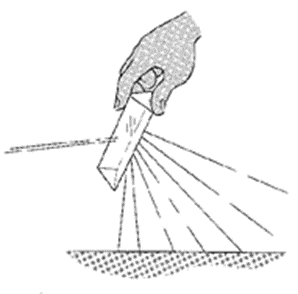
What happens to the light as it passes through the prism?
A. It bends. B. It repels.
C. It reflects. D. It is absorbed.
A. It bends.
Which of these is NOT an example of energy causing motion?
A. sitting still on a swing
B. hitting a tennis ball softly
C. sliding fast down a slide
D. kicking a soccer ball hard
A. sitting still on a swing
Addison made a sandcastle at the beach. A few hours after making the sandcastle, a wave came in and swept it away. Where did the energy which moved the castle come from?
A. The energy of moving air.
B. The energy of moving water.
C. Sound energy from the wave.
D. Thermal energy from the Sun.
B. The energy of moving water.
Which example demonstrates the use of chemical energy?
A. a ball landing
B. a burning fire
C. a magnet holding a picture on a refrigerator
D. a marble sitting still at the bottom of a ramp
B. a burning fire
Steal 200 points from the WINNING Team! If there are multiple tied winning teams, divide from each team for a total of 200 points.
Sorry, not sorry!
Some interactions involve more than one form of energy. Which forms of energy are produced when a hammer hits a nail?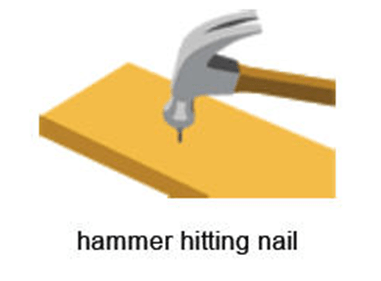
A. electrical and mechanical
B. sound and mechanical
C. light and sound
D. chemical and mechanical
B. sound and mechanical
INSTANT DANCE PARTY! Dance for 10 seconds to earn points!!!
WoooooHooooo!!!
Robin uses sandpaper on some wood. She rubs the sandpaper quickly back and forth across the wood. Robin touches the wood and is surprised.
What happened to the wood that surprised Robin?
A. It was cool because air cools wood.
B. It was warm because the light heated the wood.
C. It was cool because her hand is warmer than the wood.
D. It was warm because the rubbing motion heated the wood.
D. It was warm because the rubbing motion heated the wood.
Olivia is combing her hair. After a while, she notices that the comb attracts the hairs on her head as shown below.
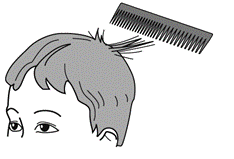 Which explanation BEST describes why the hairs are attracted to the comb?
Which explanation BEST describes why the hairs are attracted to the comb?
A. Combing the hairs caused them to lose their static charge.
B. Combing the hairs caused the comb to lose its static charge.
C. Combing the hairs gave them a charge that is opposite the charge on the comb.
D. Combing the hairs gave them a charge that is the same as the charge on the comb.
C. Combing the hairs gave them a charge that is opposite the charge on the comb.
Sorry, your electricity got turned off. Lose 200 points :(
Oh no!
Trevor makes an electrical circuit that has a switch as one of its parts. The diagram below shows the circuit he makes.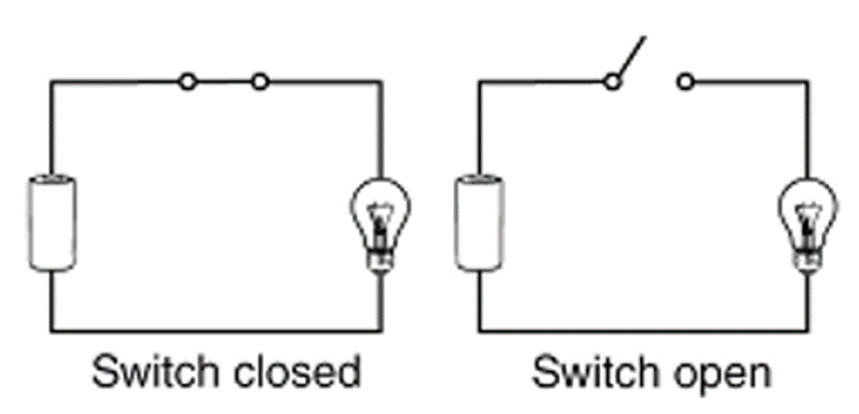
What would happen to the light bulb if Trevor changes the switch from closed to open?
A. The light bulb would make a sound.
B. The light bulb would glow brighter.
C. The light bulb would stop glowing.
D. The light bulb would start glowing.
C. The light bulb would stop glowing.
Which is an example of electrical energy being transformed into light energy?
A. turning on a lamp
B. plugging in a ceiling fan
C. lighting a candle with a match
D. bringing a pot of water to boiling
A. turning on a lamp
Marnie puts her pizza in a special container to keep it hot while she drives to her friend's house. Which of these properties does the container most likely have?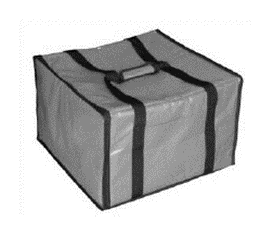
A. It will heat the pizza
B. It will cool the pizza
C. It is a good insulator
D. It is a good conductor
C. It is a good insulator
BONUS: 200 points!
Yay! And the crowd goes WILD!
The energy in a lightning bolt results from the buildup of charges in the clouds.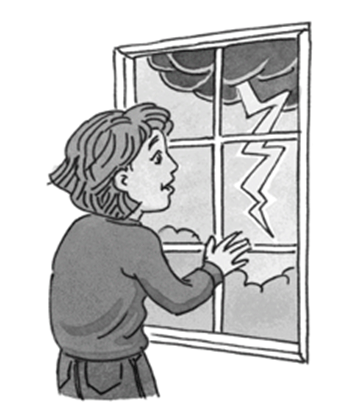
What form of energy does this best describe?
A. heat energy
B. wind energy
C. electrical energy
D. mechanical energy
C. electrical energy
The image shows a simple electric circuit. It includes a cube made of an unknown material. The light bulb glows brightly when the circuit is completed. 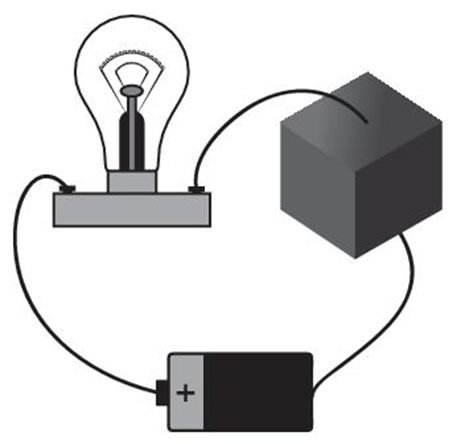 Of which material is the cube most likely made?
Of which material is the cube most likely made?
A. glass
B. rubber
C. steel
D. wood
C. steel
Erica tightens a string on her guitar. Why does tightening the string make it produce a higher pitched sound?
A. The string vibrates faster.
B. The string vibrates slower.
C. The string vibrates for a longer time.
D. The string vibrates for a shorter time.
A. The string vibrates faster.
Give 100 points to the LOSING team!
They said, "THANKS!"
A student asks her mother to help her make tea. They put a tea kettle on an electric stove and turned it on. After about 10 minutes, the tea kettle starts to whistle.
What energy transformations have taken place?
A. electric to heat to light
B. electric to sound to light
C. electric to heat to sound
D. electric to chemical to sound
C. electric to heat to sound
Which example does NOT show that energy is causing change?
A. plucking guitar strings
B. a book sitting on a table
C. water boiling on the stove
D. a soccer ball rolling in the grass
B. a book sitting on a table
The picture shows what happens when light shines on a tank of water.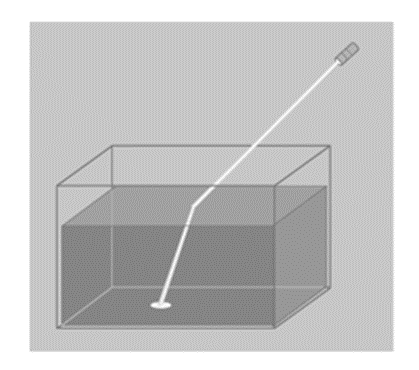
What property of light does this picture show?
A. Light travels in a straight line forever.
B. Light gets brighter the farther it travels.
C. Light gets brighter when it reflects off smooth surfaces.
D. Light travels in a straight line until it strikes an object or substance.
D. Light travels in a straight line until it strikes an object or substance.
Mr. Gorham's students are conducting an investigation in their classroom to determine which classroom object would be the best conductor of heat. Which of the objects listed would they most likely find to be a good conductor of heat?
A. a metal ruler
B. a wood block
C. a rubber band
D. a piece of printer paper
A. a metal ruler
Ariana uses balloons to investigate static electricity. Which of the following BEST explains what will happen when she brings two positively charged balloons close to each other?
A. The balloons will move apart
B. One balloon will lose its charge
C. The balloons will come together
D. One balloon will gain a negative charge
A. The balloons will move apart
Which action transforms electrical energy into mechanical energy?
A. cooling a room with a ceiling fan
B. lighting a room with a table lamp
C. warming bread in a small oven
D. playing music on a large radio
A. cooling a room with a ceiling fan
Andy wants to build a closed circuit to power a light bulb. What would a circuit look like that will power a light bulb?
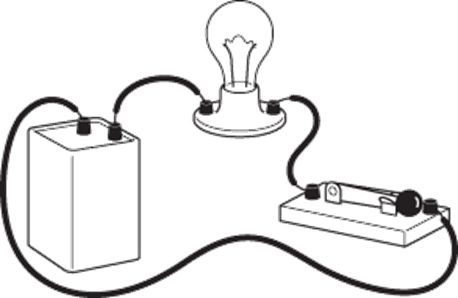
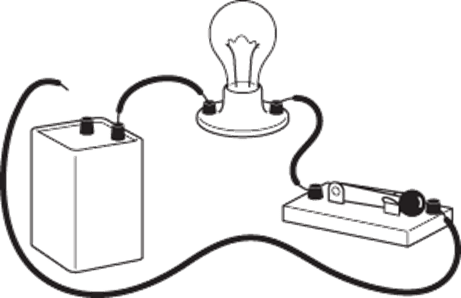
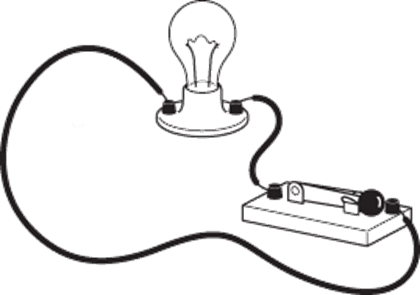
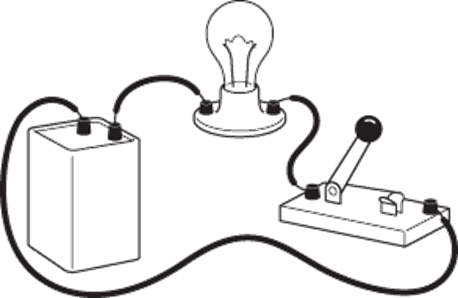
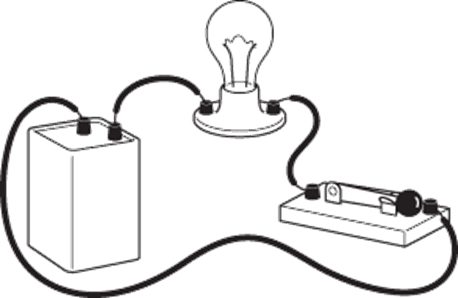
The diagram below shows the parts of a wire.
Which statement accurately describes the parts of the wire?
A. Copper and plastic are both good insulators.
B. Copper and plastic are both good conductors.
C. Copper is a good conductor, while plastic is a good insulator.
D. Copper is a good insulator, while plastic is a good conductor.
C. Copper is a good conductor, while plastic is a good insulator.
Some things can give off light.
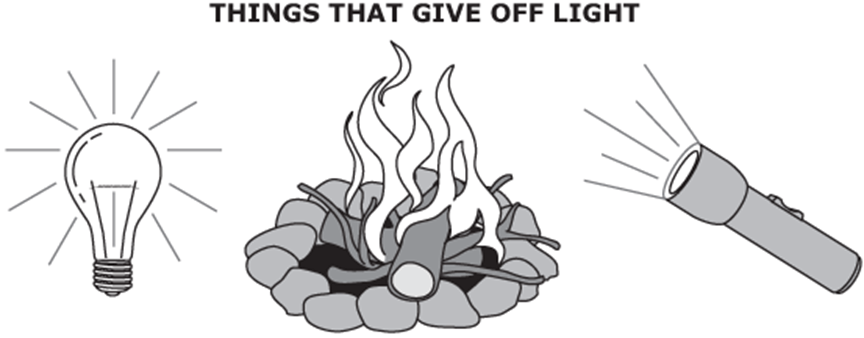
In which of the following other ways are these things the same?
A. They need air.
B. They produce heat.
C. They contain metal.
D. They use electricity.
B. They produce heat.
Illustration A shows a metal spoon that is at room temperature. Illustration B shows a pan of boiling water on a stove. In illustration C, the pan of boiling water has been removed from the stove and the spoon has been placed in the water for five minutes.
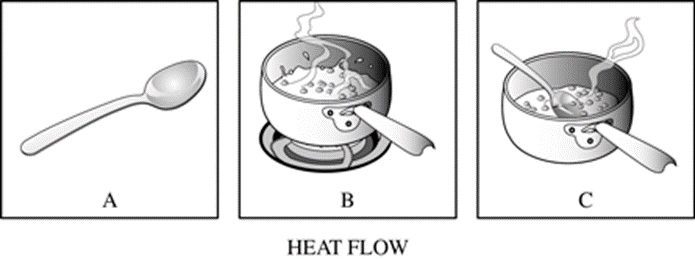
Which statement describes what most likely occurred in illustration C ?
A. Heat transferred from the water to the pan.
B. Heat transferred from the water to the spoon.
C. The temperature of the water remained the same.
D. The temperature of the spoon remained the same.
B. Heat transferred from the water to the spoon.